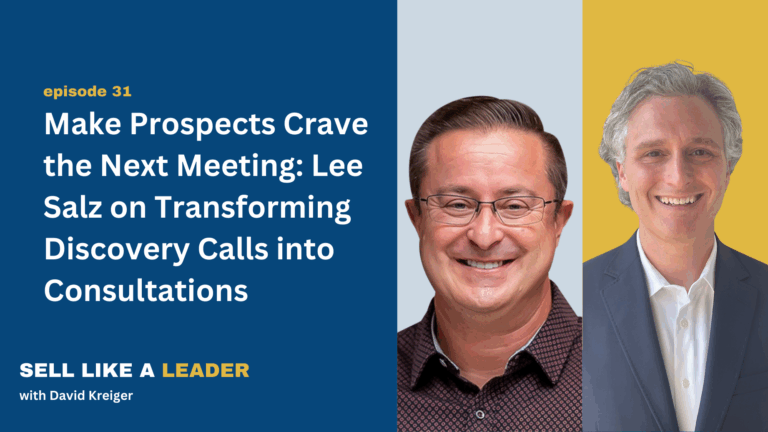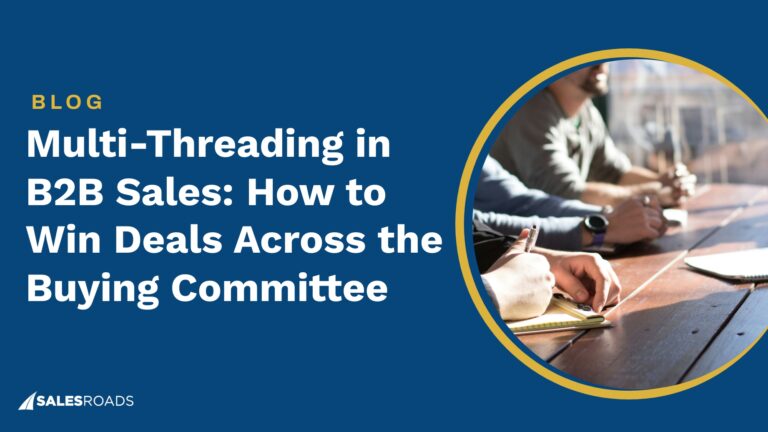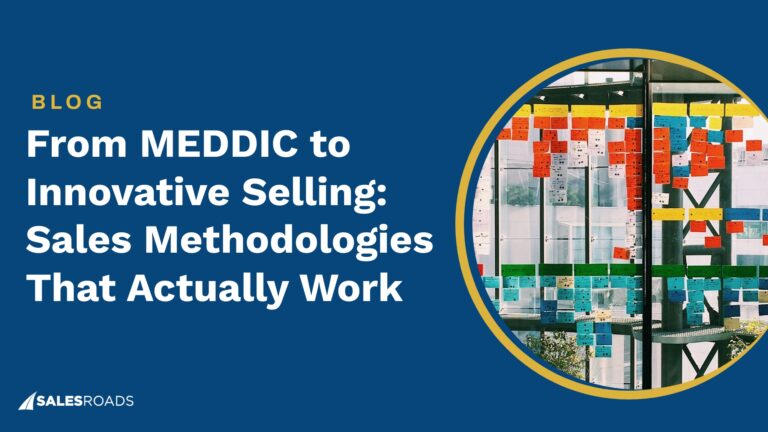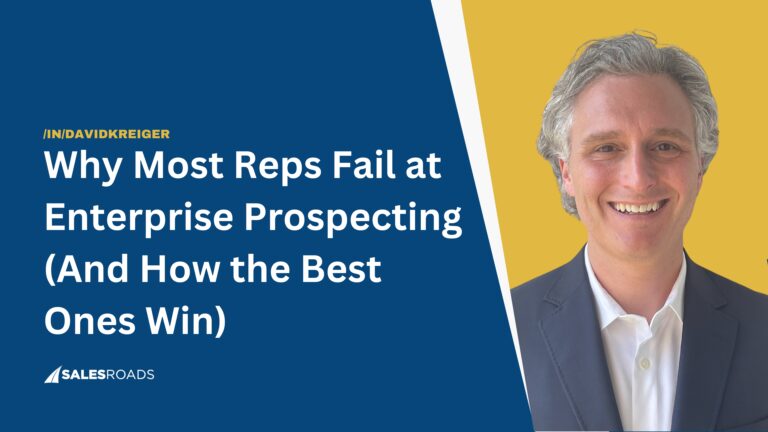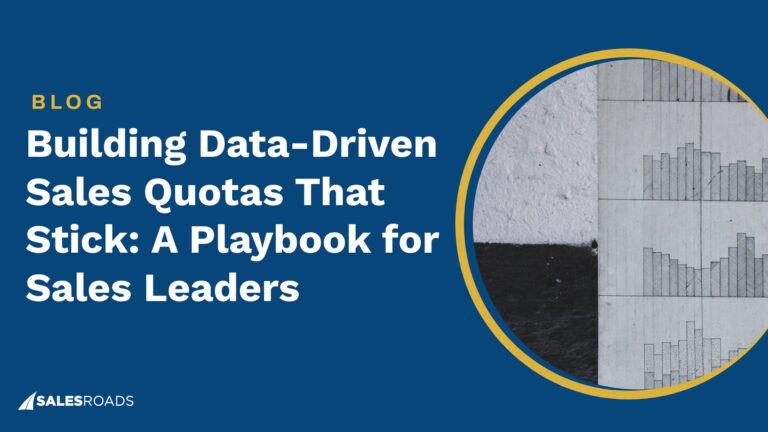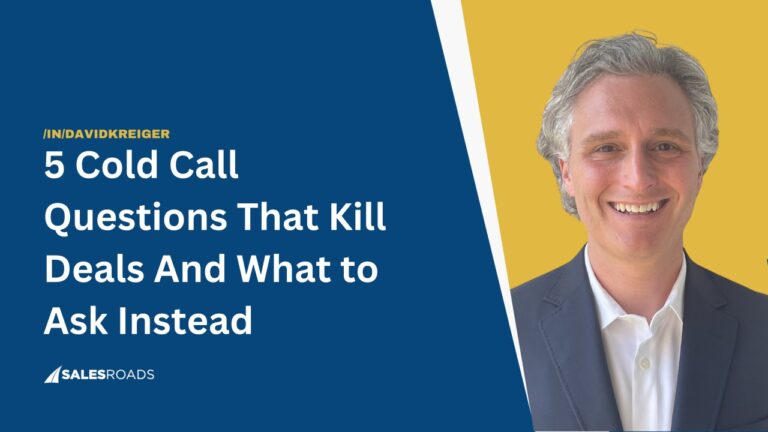Sell Like A Leader – Episode 18
In this episode, we dive into:
– Strategies for high-performing enterprise sales teams: behind the scenes of Gong’s growth, the need for a different playbook when transitioning from SMB to enterprise sales, tackling enterprise-level challenges, the right time to hire frontline managers when building enterprise sales teams, coaching your team on account planning, the “groundswell outbound approach”, why extended enablement programs are key, the role of customer success when going upmarket and building trust between sales leaders and their teams.
– Rapid Fire Q&A
About Bob Spina
David Kreiger chats with Bob Spina, who is developing a Sales Advisory practice and has just departed from ON24, where he led Enterprise Sales. Previously, Bob led the strategic sales team to record growth at Gong. He has a proven track record of unlocking seller performance and building high-performing teams across various organizations, from startups to mid-sized firms, and even a half-billion-dollar business at Cisco.
Podcast Key Takeaways
- Transitioning from SMB to enterprise sales isn’t just about the product—it’s about changing perceptions and aligning value propositions with strategic initiatives at high levels. Bob emphasizes the importance of building a playbook that resonates with larger enterprise challenges.
- Instead of focusing on sheer volume, Bob’s approach involves meaningful and strategic interactions, utilizing data to support major company initiatives. This high-quality engagement has proven pivotal in Gong’s enterprise market penetration.
- Building trust within the sales team and across departments is non-negotiable. Regular alignment meetings between sales, customer success, product, and rev ops ensure cohesive and successful product adoption.
Connects
Connect with Bob Spina: https://www.linkedin.com/in/bobspina/
Connect with David Kreiger: https://www.linkedin.com/in/davidkreiger
Subscribe to the podcast and follow our Podcast LinkedIn page so you don’t miss any episodes!
Transcript
David: Welcome back to another episode of the Sell Like a Leader podcast, the podcast for revenue leaders who are on a mission to cultivate high-performing sales teams. I'm your host, David Kreiger, founder of SalesRoads, America's most trusted sales outsourcing and appointment setting firm.
Today, Krieger. So excited to bring you another revenue leader who I actually got to know in 2020 back in the difficult time period that was for SaaS sales.
And Bob Spina. He is an amazing individual with just a wealth of experience in sales, enterprise sales leadership. Um, he is currently developing sales and a sales advisory practice and has just departed from ON24 where he led enterprise sales. And now, and this is an amazing opportunity if you guys want to work with him, is a fractional CRO.
Bob led the strategic [00:01:00] sales team to record growth at Gong, coming in to lead their enterprise division just after they had thought that they had product market fit amongst the SMB market. And we're going to dive into that. It's a really fascinating story. Um, he has just had a part in multiple successful exits and created teams that just really know how to deliver in the enterprise space.
So let's jump in. Welcome to the show, Bob.
Bob: David, thank you so much for having me. I know we've been talking about this for a number of years, and I'm glad we finally get on the calendar. So I'm excited. Yeah,
David: for taking the time to join us here. I know the listeners here are going to get some amazing tidbits here in the enterprise selling. And so I want to dive right into your experience at Gong. Because I think a lot of folks they see what Gong is today.
They understand the amazing growth that they had, but it's always interesting to peer under the hood at what drove that growth and, I'd [00:02:00] love to dive into what are some of the lessons that you learned coming into Gong and trying to develop that sales motion and were there any specific surprises that you felt coming into Gong?
Bob: That's a great question. I was an early adopter of Gong. Zix, which was acquired by OpenText, started using their solution in 2017. And as an aside, I'm friends with Amit Bendov, the founder of Gong. It's actually the third company that I worked together with Amit. So besides being the early adopter, we were talking, he's Hey, I have opportunity for you.
We're doing great. Why don't you come lead enterprise? I loved the product early on. It was basically recording conversations, but I got a lot of value out of it. So I jumped right in January, 2020. And they were doing fantastic. Just to give you a quick history, they were really focused on SaaS and tech companies in the Bay Area of California, mostly selling [00:03:00] to commercial sized businesses, which were 500 to 1,000 employees at most.
And most of those organizations had an inside sales team as well. And I joined the company was under 20 million. I think I was employee like 170, just to give you a flavor. We had a couple salespeople that I took over that were selling upmarket. And Gong had a tremendous playbook in SMB. And one of the things I've always thought of myself as a leader is let's be open-minded.
These guys are doing great. They're killing it in SMB and they were doing it by running like pilots that were led by sales reps. And they're closing a small pilot that they would run in three or four weeks. And then they would basically show them the data and close the deal. And they were just killing it with that.
So I'm like, okay, let's go. Let's run this play up market. I don't want to bring my enterprise playbook here and be biased if they already have something that's working. [00:04:00] So let me give you a little bit of a recap that might be helpful to the listeners, as some of the surprises that we hit going up market.
First of all, when you think about the Fortune 1000, most of those are enterprise sellers themselves. They do have an SMB traditionally, but most of them are managing their large accounts. If you think about even a Cisco or Hewlett-Packard, or Oracle, a lot of their revenue is someone handling one to three accounts and closing million dollars of revenue.
They had an immediate bias towards Gong. They didn't want to be recorded. They thought it was performance management. And they had a lot of weight inside their organization to resist the technology. So we had to overcome all of this apprehension by the senior sellers, even in the tech vertical, and not to mention breaking into new verticals that had never heard of Gong, which I know people don't [00:05:00] believe these days.
We're going upmarket in a way. We had conversation intelligence and revenue intelligence, and we were, and we really were evangelizing the art of the possible then. So once we got a foothold in these accounts, we had another headwind that we didn't really anticipate, and that was security and compliance.
So I think you've used Gong or technologies like Gong, and in order for it to be effective, it needs to connect to your CRM. It needs to record all of your virtual meetings. It should be connected to your calendar and your email. So think about all the data that Gong is consuming in order to give you those insights that help you manage your business.
The security compliance team in the Fortune 1000 was like, hold on, you have the keys to our castle. You have a lot of intellectual property here. Oh, no, by the way, it's going to where, it's going to someone's cloud. It's not even in our own network. We hit that headwind as [00:06:00] well. These are some of the surprises that I ran into where I thought I did have a good playbook and product market fit.
David: Let's dive into those challenges and maybe talk about how that changed the playbook that Gong had, how you drew on some of your experience at other organizations, the type of enterprise playbook that you wanted to bring, and where you netted out.
The main value prop that you were bringing to SMBs, which is listening to conversations, helping managers manage those conversations, was immediately rejected or there was pushback or uncomfort. So, how did you address that challenge, and how did that evolve into the playbook that you were able to develop for Enterprise at Gong?
Bob: Yeah, ultimately, the way we solved that is we had to bring business value way beyond just coaching and conversations. And what we did is we really pushed hard on [00:07:00] strategic initiatives that were going on at the company.
And when you think about a Fortune 1000 company, say they're a manufacturer as an example, they have great data on what they build, all the parts, where they buy those parts from, who buys all of their products. So they have this dataset around their products. Then they have great financial data, right? All of their finances, what their costs are, what their revenue is. They're keeping track of all that data, but the big missing component, they did not have their customer interactions.
So when we realized that we had this powerful piece of data that we could bring to a Fortune 1000 company that they could make their most strategic initiatives successful, this is when the light bulb went off, and we really started to close some very large strategic deals.
As an [00:08:00] example, we're talking to one of the largest staffing firms in the world, and they wanted to transition to a professional services company. Traditionally, they would get all their sales reps together. They would train them on, all right, this is how we're going to sell services now. And then they would go out and try to sell it.
And they had no idea. Was it being successful? Was their messaging and training being adopted? What was the market saying about their new service? We brought all of that to them. So this is like a billion-dollar initiative from the board level down that we said, here's the last mile of data that you need to be successful.
And we needed to have salespeople though that could sell at that level and challenge conventional wisdom. And say, you're not going to be successful doing this the way that you've been doing it. And that's really what was a breakthrough for us in the playbook.
David: I think that's so fascinating. So you guys had to be open-minded enough, your team had to be open-minded enough [00:09:00] to get the insight that basically that's not the value prop for enterprise.
It's collecting customer data, understanding the customer journey, and we're uniquely positioned in a way that there's no other tool that's gonna give them these types of insights.
And even though you had basically the same product. I'm sure you guys added things, security, and other things like that. You had to take what was product market fit in one market and apply it in a completely different way or with a different mentality to enterprise to achieve a different type of product market fit.
Bob: That's correct. But we did use all of the goodness that Gong had in SMB did show up again. If you think about the initiative. You still had to help frontline leaders coach to, is this initiative working? Are we closing deals? Is our forecast correct based on this new initiative? So, think about launching a new product, is the product landing right?
Is it priced right? Are frontline [00:10:00] sellers presenting it right? So all of the goodness that we had around coaching and deals still came through in the enterprise. It was just positioned in a different way.
David: As companies or leaders who are listening to this, who might have product market fit in SMB and they're looking to create their enterprise team, can you walk us through what a playbook or framework would be for sales leaders trying to create this type of division within their company?
Bob: There's a few things, and you had one of my friends on the show, David Ribenstein, who used to be with Outreach. He talked a lot about picking enterprise accounts and the thoughtful process that went into that to pick those accounts.
We took it a step further, and I think David does as well. We're maniacal about account plans and really thinking about very strategically what was going on at the companies that we had [00:11:00] targeted.
So, how we did it at Gong, to give you an example, is originally we were going after companies that had the largest revenue teams. Because we’re pricing it on a per-user basis. So if you were a sales rep, customer success, SDR using Gong, you would pay a license for that.
So, of course our TAM was, let's go after companies with the largest sales teams. But then, what we really started to do is be very prescriptive about account planning. What's going on with this account? What are the strategic initiatives that the board is putting forth with the CEO? What are their competitors doing? And we came with a very strong point of view.
Because that's the other thing. We were going all 99% outbound. So we did not have incoming leads at this point. Gong was not a brand in the Fortune 1000 business yet, where it was bringing us a lot of inbound. So we had to break a lot of glass. Everybody [00:12:00] talks about TAM, SAM, SOM, ICP, like we narrowed it down to maybe 200, 250 accounts in the United States that we were going to own.
And we spent a lot of time on account plans and then, that worked its way through enablement. We had a very strong enablement process. And one of the key KPIs we measured was the quality of the account plan. Not just that it was done, but what was the quality? What was the point of view that the rep had?
So when they were going to talk to somebody, did that point of view make sense? So I think that's the first thing I would say is if you're going upmarket, be very prescriptive on the accounts that you pick and the playbook that you build around you, the point of view on the accounts that you have.
I really trained the team to do that well.
David: Can you give us a little bit of advice at Gong or just your experience?
You said you initially at least wanted to go after the biggest companies. How [00:13:00] did you narrow it down to think through where you guys would be best positioned to win those accounts to be able to choose those 250 accounts with your team?
Bob: Because of the early headwinds we had with security and compliance, in the beginning, I removed any regulated organizations. So we didn't go after finance, as an example. We didn't go after pharmaceutical, even though they had huge sales reps. We knew that it would be a HIPAA compliance issue to record a conversation with a physician.
So even though they looked good, they had a lot of sales reps, we started to remove things like, okay, this is not going to fit because we were going to get this headwind. We don't want to invest there. The second thing we did is we didn't want to evangelize going to the cloud. So we had to look at the companies and say that they had already at least adopted using the cloud.
They already had a CRM in place. And believe it or [00:14:00] not, in 2020 to 2021, there were some Fortune companies that had not adopted cloud, had not gone out, had not implemented a CRM. They were still running on a homegrown system and doing quite well. So one of the advantages we had were all our great integrations.
So we didn't want to evangelize that. So we started chipping away at the list and said, okay, now these are a very good fit. They fit in.
And then the other thing is we didn't want to train the team on some really unique business acumen that was going to be really hard to demo and have Gong adapt to a unique business.
We did it by a process of elimination because we wanted to build a very repeatable playbook. At that point, if I had a rep on the West Coast who was closing Google, I wanted him to share all of that with the person on the East Coast. So we were able to iterate things that were working and not working so quickly. [00:15:00]
And it just caused us to course correct. Like we always validated what we were doing with data. And I think that's the most important thing that I learned at Gong is I always considered myself data-driven, but when you're a leader, remove your bias about your hypothesis. It's okay to have one, but back it up with data and continually check it.
Don't be afraid to course correct. The data's showing us we're off here. Let's back out of this.
David: Yeah. And I've seen it time and time again, and you want to go after the whole team, and sometimes it's driven by investors. You want to show you can appeal to the whole market, but create the plan that you go here first and then you expand. Because if you try to go after everyone, especially when you're breaking into a new market and having them do things in a way that they've never done it before, it's just really difficult.
So can you give a few pointers for our listeners, too on account planning? So you talked about having a point of view on each account. How did you coach your team [00:16:00] to develop, to do the research, what to research, and to create that hypothesis of need, or however you guys framed it?
Bob: Yeah, we actually brought in an enablement person, and half his time was spent around account planning.
So all of our workflow and everything that we did as an organization had account planning built into it, and we actually built it into the enablement plan of the new reps that we hired.
So the manager was responsible for checking the quality of the account plans. And because we met every week as a team, we would share great examples of the account plan. And salespeople generally don't like to do that exercise. So what we then showed them is like, alright, Johnny did the Verizon account plan, and look at this meeting that he had, and this opportunity he opened because his point of view was so good.
So we kept sharpening. You [00:17:00] just can't throw account planning over the fence. It really has its own life inside an organization. You're going to get a lot of resistance because it's very administrative and takes time. But once people see that they're winning with the account plans, then they'll start doing them.
And we also removed a lot of the things in Quip that we didn't need. We didn't want them just to write a novel for the sake of writing a novel. We really focused on the components that were valuable to us.
David: Can you break down some of those components? Just that, obviously it's so different in each organization, but I think it's helpful for sales leaders just to get a sense of what are the types of components that would go into…
Bob: Sure. Yeah. A lot of people, they do some company research. They see what business they're in. They'll do an org chart. And then if the company is publicly traded, they might read a 10-K, and then it stops there. But we did all of that. But then we actually wrote a point of view based on [00:18:00] what is the CEO saying?
What are they doing? What are their competitors doing? What's the market doing? What's the industry doing? So we actually started to study the market. So if we were going after AT&T, as an example, what's Verizon and T-Mobile doing in that same line of business? What are their headwinds in that business?
So when we talk to them, let's have a good view on it. And we actually built that right into the account plan. And then we tested it. Like, the leaders that I had really did coach and test out the points of view, which were very important in our outbound. The other thing we did is we took that point of view — and you know how everybody says you got to go right to the top, all right, let's call on the CRO of ADP, right?
No, here's what we did. Like, we took that point of view. We found a regional director at ADP. And we asked them what was going on in their life. Like, this initiative reached down to them, what was it like [00:19:00] in their world? And then we asked who they reported to. And we were maniacal about this org chart, and we worked our way up.
We did something called groundswell outbound, where we got all this data. And then we went to the next line of leaders, and we met with them. Our point of view was so sharp because we had talked to their frontline. And then when we finally got that at bat with a C-level, we said, Hey, we just talked to David in your organization.
In fact, we talked to a few other people, and this is what they're telling us. And usually they're pretty impressed that we did our homework. So we didn't swing our bat right at the C-level right away, coming out of the account plan. We tested it out. We had the SDRs use part of it. It was just embedded in like our DNA as a sales organization after a while.
David: I love that groundswell of... And I think people do that, but they don’t do it in a process-driven way. Like they’ll say, okay, maybe I’ll talk to a few people here. [00:20:00] I’ll get some info. And it’s not even a lot of times intentional. But I think the way that you guys structured that — where you are basically building a point of view, a hypothesis, and building data as you went along to move up the ladder — is a really strong process.
And I’m curious, how did you make sure that all that data was shared? Because I think a lot of times people will do this. They’ll talk to this person, they’ll talk to them, but they have notes under different contacts and it doesn’t go together. How were you able to aggregate all of that data into your account plan and into those conversations as you moved up the ladder?
Bob: Yeah, that’s a great question. Gong was not just ingesting recorded virtual meetings. It was taking in our email and cell phone calls and so on. Having Gong did give us a good history of it, but every rep also had an SDR. [00:21:00] And we complained so much about the SDR that they gave it to me. So I ended up leading the enterprise SDR org, and we completely ripped that apart and built a playbook.
And in that was a document. We couldn’t get it in Salesforce. Unfortunately, we still used a Google Sheet for each account of all the conversations and highlights and things like that.
So we were collaborating in Google. We just found it faster. There’s probably a better way to do that. But the SDR link basically was out of Google. We would put the link to the Google Sheet in the account record in Salesforce. And that’s what we did.
David: It’s a process that aggregates it. And the worst thing is to have it in Salesforce and it lives in so many different…
Bob: Yeah.
David: Um, so you were building the enterprise team. Can you walk us through how it changed? How did you structure it? And how were you able to build it over time in the right way?
Bob: That was a time when, again, there was a lot of [00:22:00] investment capital. And we had early signals that we were winning in enterprise. And then we landed our last investment — I think it was $250 million — about a year after I joined. And that’s when we really put the pedal to the metal.
And a couple of lessons I learned there — I mentioned it briefly, but I should have hired frontline managers a little earlier.
But that was the point where, a few months before the investment, I brought in four fantastic RVPs. They were so complementary to each other. I don’t think I’ve ever had a better team. They’re world-class. That made me go so much faster. So I would say, if you’re building this segment, hire your frontline earlier than you think you need it.
What a lot of people do — and what I did — is okay, I’m going to have six, eight direct AE reports. Then I’m going to hire my first, say, [00:23:00] director or RVP. I recommend just hire them first. And then let them build out their team. So I would say that really helped me scale. And then they were so talented that I was able to divide and conquer all the things that we needed to do.
So I would say also delegate to your RVPs. Most of them want to be CROs anyway. And I was like the CRO of the enterprise strat business at that point, or the general manager, whatever you’d like to call it. We were running our business.
And I had to work a lot cross-functionally as well. So I had built those relationships early.
Customer success as an example. We wanted people to be very successful with Gong, and we were running a land-and-expand playbook. So CS had to really not only drive adoption, but show real value. And I met every few days with CS at that point. And I think it's important just to have this really cross-functional alignment [00:24:00] when you're going up-market in an organization.
I met with Product every week, Enablement. My RevOps person was like my chief of staff. So really, I think you need to build out the infrastructure. In other words, if you're going to scale it at that level, think about it. Like, I went from three people to outside sales reps, 45 or 50 in less than eight months.
So there was a lot of interviewing, a lot of enablement, territories and so on. So you have to have that infrastructure built around you to scale, even hiring.
So think about we needed to hire this challenger, curious, not process-oriented type of person, and then suddenly pivot to having people that—I want you to follow this process now. So we had a blend of people together, and enablement just became really key. I'm happy to share this when I have the users, but we built an eight-month enablement plan, [00:25:00] not a 30-day plan.
We tracked our hires for eight months, and it wasn't just around how many calls or how many emails, but it was like—month by month—this is what you need to do to be successful selling enterprise solutions at Gong, and the managers had to check in. Enablement was involved. We recorded things in Gong. It was just a really amazing process.
We didn't want to hire someone and a year later, let them go. We wanted them to be successful.
David: Yeah, so can you give us a few examples? I think a lot of folks obviously have a 30-day enable. They maybe have a 90-day, but what are you doing at month 7 at Gong for your team in that type of enablement plan?
Bob: At month seven, you think about—if we're going outbound and you're selling a new technology to an organization, they don't have budget for this. So you have to celebrate and measure all the key [00:26:00] moments of the sales stages for your new reps. They're going outbound to an account, they're helping build an opportunity, they're building a business case.
So we're measuring the middle stage of sales opportunities along with—are their account plans really working? Are their POVs working? Let's listen to their calls. Are they really delivering what they're supposed to be delivering? And then we started measuring, I think, something that's become popular today, but back in 2020, 2021, we were measuring quality connections.
Like a lot of people measure how many outbound calls did you make? How many emails did you send? Now we were measuring like—did you talk to the right person at this account this week that you needed to? All right. And if it took them a hundred calls to get there, like we tried to figure out how we can shorten that.
So, month seven was more or less: do they have the signals in their pipeline and their acumen and their mastery of Gong [00:27:00] that's going to get them over quota the next year? Because I invested in my reps. I gave them six, nine, and in some cases, a 12-month ramp. So like we knew it was going to take them almost a year to build out their business, and I had the privilege of really investing in people.
David: You're building this team in a unique time during 2020, where you weren't necessarily getting to meet all these folks. I'm just curious what you feel and how you maybe fostered, especially during this time, the role of trust in a sales leader and his team, and how they're rolling out their businesses.
Bob: Now, this is one that's really important to me because, as a leader, I've always wanted to lead from the front. And one of the things that's made me successful is I always have a team that really believes in me. And building trust—it just doesn't start with your team. Like [00:28:00] even though Amit and I were friends, I had to build trust with Amit, right?
Think about the long time period of me building up this business. So with me, it was more like—do we have the right talent? Bob, are these the right folks? Are we getting the early meetings with these accounts? Do we have the right forecast? And then there wasn't just me showing up one day saying, Oh, I think we're running into some security problems. I show them like, these are the Gong calls.
This is the stage we're stuck at. These are opportunities. This is what I need. Trust of asking for things that it's backed up by data. That's trust building up. And I think with the sales reps, they really started to believe in the program that I had put together. The enablement, why I believed that they would be successful, the accounts that we had picked, and how we were helping them.
Like they saw that it wasn't just like sales-led outbound, they saw we have an ABM person. Oh, Bob brought an Enablement [00:29:00] person to help us with account plans. We have our own RevOps person, so they're saying, like, Hey, this is a real program that we're buying into at Gong. And I know I'm probably not going to kill it my first year, but look at the people that were hired the year before me.
They're doing very well. So I think there's a lot to talk about trust, but I also think just listening—like I listened to my RVPs, like they challenged me, but I listened to them and we solved a lot of things together. So I think also just having an open mind helps build trust.
David: Well, last question—I think actually you just recently posted about this—that you're a fourth-degree black belt in Taekwondo along with your wife. So that's pretty amazing. Can you talk just a little bit about how this discipline, the training in this art, has helped you over the years with your professional skills?
Bob: Yeah. This is like my third love besides my wife, my family—I just love [00:30:00] Taekwondo and what it's done for me. But specifically, besides the physical benefit, Taekwondo has tenets, like courtesy, integrity, perseverance, self-control, and indomitable spirit. And when you think about building a startup or running your own business, living through a pandemic, there’s two things that I really always lean on, and that's perseverance and indomitable spirit.
And the indomitable spirit part is you just can't be broken, and you just know and trust in yourself. And there's a strength in that. That's really gotten me through a lot personally and professionally. The real true value of this is the tenets.
And I think that's also come through in my leadership. It's just who I am now. Early in my career, I thought I had to be the super rep, close every deal, come at the end, lead out of fear—and it might work for a little while. But once I became my true self, and all of this came as part [00:31:00] of me, it's really when I took off as a leader.
David: That's beautiful. Love it. We like to do rapid-fire questions. And I'm going to ask you a series of questions, and if you can just give us a sense of what you're thinking about that. Sound okay?
Bob: Sounds good. Let's see how I do.
David: What is the one thing people don't give enough value or attention to in leadership?
Bob: I think emotional intelligence in leadership. A lot of people always show up with what they're going to do and really come into a room already having their mind made up. And EQ builds—you know, it's just a critical role, especially in building collaboration and trust with people.
And I think it helps you connect with people on a more personal level as well. And like at the pandemic, we had to have two coaching sessions every week instead of one. Like, one was just personal coaching. My kids are home from school. My partner is home. How am I going to do this?
And I had to really figure out how [00:32:00] do I unlock the performance code out of my team at a time that is so unique. And I think EQ really did that for me.
David: What is one skill you advise everyone in sales to master?
Bob: Active listening is really the key. It's just not waiting your turn to speak, and when the other people are talking, you're thinking of what you're going to say. And I get guilty of this, like someone will Slack me, or I'm multitasking, and I'm in a one-on-one, and I'm not present for that person. This will help you build trust. You really understand what your prospect is saying if you're in sales, and that you also ask better, more targeted questions as you go forward.
David: Favorite business, leadership, or sales book?
Bob: I tell you, my favorite still—Matt Dixon, The Jolt Effect. I would encourage everybody to read it. It talks about how people, you're losing all these deals to indecision. And you gotta jolt people out of it.
It's a [00:33:00] deal killer.
David: Yeah, it is. Obviously, for sales, we have the most frustrating thing. I think we all agree—we prefer a no to just like indecision. That is, I'm not getting, and it's out there and we're still following up, and it's—so jolting them to either say yes or no is really important.
Bob: Correct.
David: Favorite quote, mantra, or saying that inspires you as a sales leader?
Bob: I'm probably going to show my age in this one. I don't know if folks who listen are familiar with Zig Ziglar. Zig was the first person, trainer I ever listened to in my career. And he had this saying, "If you do the things you're supposed to do when you're supposed to do them, you can do the things you want to do when you want to do them."
David: Yeah, I couldn't agree more. And finally, what is the most important goal or project you're working on right now?
Bob: Actually, I have two goals. I've returned to Taekwondo. So personally, I do want to test for my fifth-degree black belt, which takes quite a while to do. And it's just [00:34:00] something I really want to push myself to do. And then professionally, I left ON24, and I'm building this advisory practice.
I picked up some clients right away just from people I know. So I'm trying to see—is, do I bring a unique perspective to an advisory? How can I add value? And is there a place for me in doing that? So those are the two things right now.
David: I think anyone listening to the podcast today would say that you provide unique value. I really appreciate you taking the time today to share your insights, your learnings, your wealth of knowledge, and so really appreciate it. And so Bobby, if people want to reach out, how do they find you?
Bob: My LinkedIn profile is up to date. You can get me through email there, and I'd be happy to connect with anybody.
David: Fantastic. Thank you, everyone, for tuning into another Sell Like a Leader podcast. This was awesome, Bob. Thank you again...
David: Fantastic. Thank you, everyone, for tuning into another Sell Like a Leader podcast. This was awesome, Bob. Thank you again so much for all of the insights that you shared today. And folks, if there's any questions you [00:35:00] have for me, always reach out to me on LinkedIn.
Great to have you with us, Bob. Thanks again.


